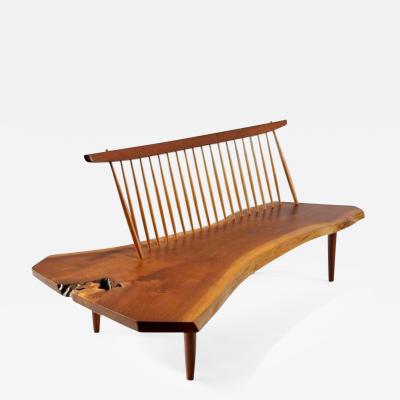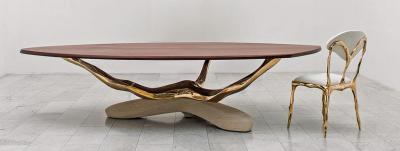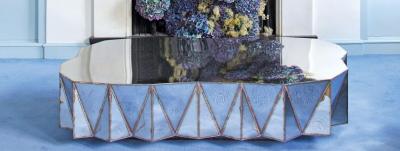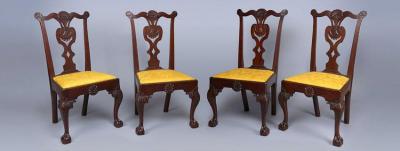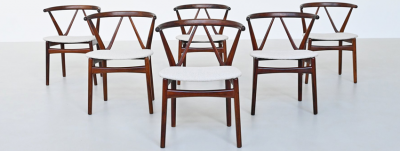Wendell Castle (1932-2018)
In January, the “father of the art furniture movement” ― Wendell Castle― passed away. One of the most celebrated designer-craftsmen of the past six decades, Castle influenced several generations of craftsmen and women and his works are in private collections and in more than fifty museums and galleries worldwide.
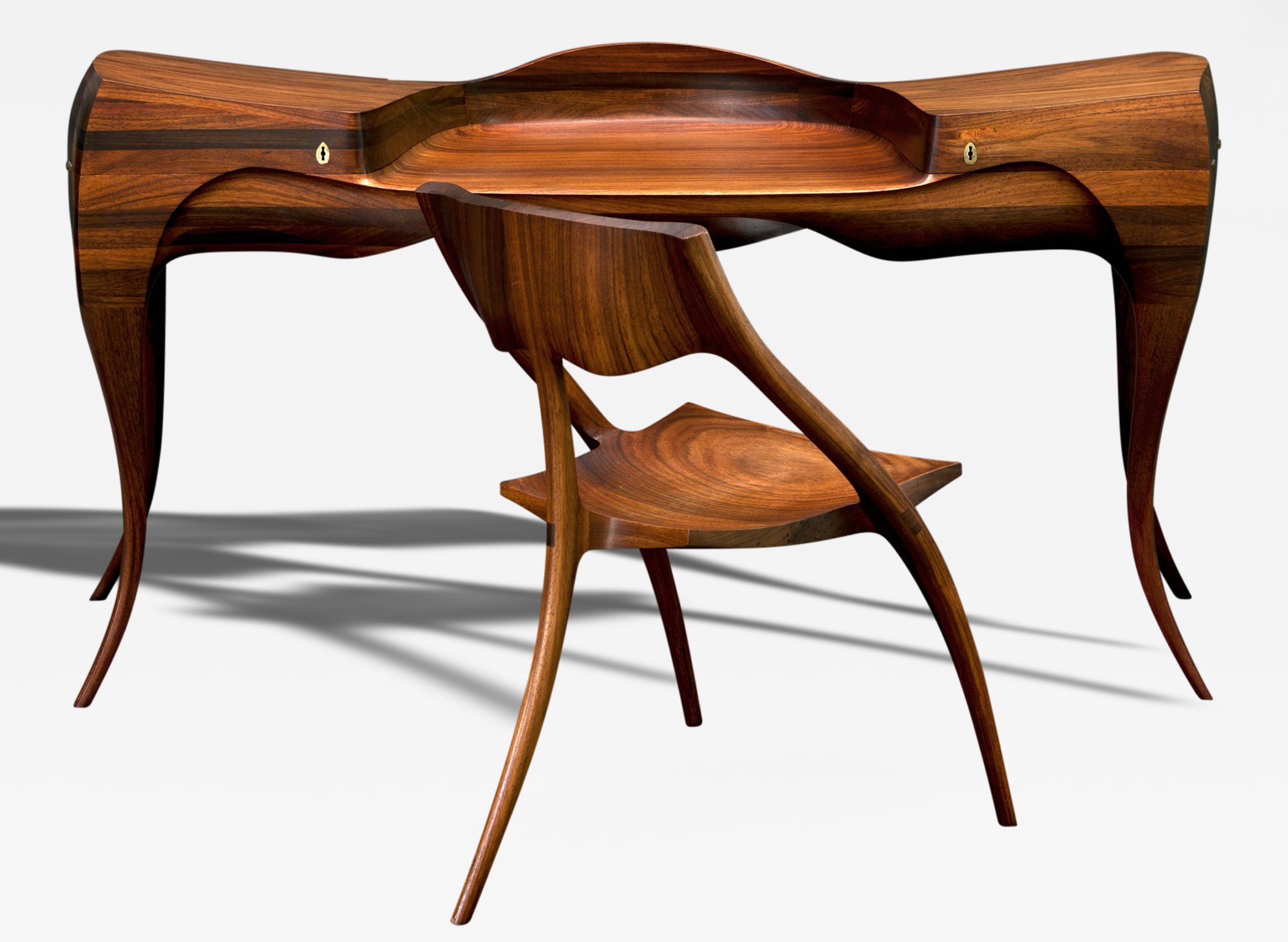
Wendell Castle, Vermilion Desk and Chair, 1965. Vermillion wood; desk: H. 34, W. 62, D. 24. Until its acquisition byLost City Arts, this desk and chair remained in a Rochester, New York, family since its purchase from Castle in 1965. |
Inspired by the studio furniture movement of the 1950s and the instrumental craftsmen George Nakashima and, in particular, Wharton Esherick, Castle got his start in the late 1950s and early 1960s with training in sculpture and industrial design. These threads continued throughout his career, first with his laminated furniture designs in the 1960s, typified by his “Library Sculpture,” made for an exhibition at the Memorial Art Gallery in Rochester. The first studio craftsman to regularly use stack Lamination in his work, the method freed him from the constraints of, in his words, the “linear flow of wood grain,” noting, “Wood, I realized, could be shaped and formed and carved in ways limited now only by my imagination.”[i]
 Wendell Castle, Molar Lounge Chair, Manufactured by Beylerian, 1970s. Fiberglass, H. 24, W. 30 ½, D. 30 in. Courtesy Tishu.
Wendell Castle, Molar Lounge Chair, Manufactured by Beylerian, 1970s. Fiberglass, H. 24, W. 30 ½, D. 30 in. Courtesy Tishu.While continuing to create his laminated furniture through the 1970s, Castle branched out into plastics, Styrofoam, and fiberglass in the late 1960s, introducing, among other things, a line of fiberglass-reinforced polyester furniture produced by Wendell Castle Associates at his Scottsville, New York, studio. The freedom this material offered Castle allowed him to delve into the realm of Pop art. These organic works of sculptural furniture provided the opportunity to create either limited-editions or multiple series of the same design―such as his “Molar” series. During this period, Castle’s reach and influence expanded with greater recognition and exposure in galleries and museum exhibitions.
In the late 1970s, Castle turned from his experimental designs to focus on the craft of making fine furniture using traditional woodworking techniques to create exquisite furniture in exotic woods. He showed his prowess with finely crafted forms that often included a tromp l’oeil effect such as a pair of carved gloves and keys atop a formal card table; he referred to such forms as “illusions.” This work received little attention at the time and Castle turned his focus in the early 1980s to adding a contemporary spin to historic Art Deco and Biedermeier styles, with an emphasis on vibrant veneers and craftsmanship. It was Castle’s furniture in this vein that elevated studio furniture to an expanded national audience beyond the craft circles when his New York gallery representative heavily marketed and sold Castle's furniture, including a writing desk and chairs for the then unheard-of price of $75,000. Thus set the wheels in motion for the studio furniture movement in the broader marketplace, with increased gallery exposure and more publication venues focused on studio artists.
In the 1980s, Castle integrated bright colors, metals, and whimsy into his furniture designs, crafted with the assistance of his workshop. With this foray, Castle circled back to producing forms with their essence in sculptural design versus function. In 1998, Castle founded The Wendell Castle Collection, which produces hand-crafted examples of his original designs as well as pieces “conceived by his design team and developed under Wendell Castle’s guidance.”
 Wendell Castle, “Donut” End Table, 1988. Stained curley maple on polychrome base. Signed and dated. Courtesy Moderne Gallery.
Wendell Castle, “Donut” End Table, 1988. Stained curley maple on polychrome base. Signed and dated. Courtesy Moderne Gallery. Wendell Castle, Table, 2003. Carved, polychromed, and crackle-lacquered wood, burlwood. Courtesy Todd Merrill Studio.
Wendell Castle, Table, 2003. Carved, polychromed, and crackle-lacquered wood, burlwood. Courtesy Todd Merrill Studio.Throughout his career, Castle shared his knowledge and design sense with others. From 1963-1969, he taught at the Rochester Institute of Technology, accepting a teaching position at SUNY in 1969. At RIT’s School for American Crafts, he continued to teach a graduate industrial design seminar until recently, where he was also Artist-in-Residence. Wendell Castle has been included in many publications and exhibitions, including Furniture by Wendell Castle (1989) at the Detroit Institute of Arts, which further legitimized the movement as it was burgeoning onto the collecting scene. In addition to his three honorary doctorates, his numerous professional recognitions include a 2007 Lifetime Achievement Award for Excellence in Design from the Brooklyn Museum of Art and a gold medal from the American Craft Council. Most recently on January 17, 2018 at Christie’s auction house in New York City, though absent, Castle was awarded the Award for Excellence in the Arts from Eric M. Wunsch of the Wunsch Americana Foundation.
[i] Cooke, Ward, L’Ecuyer, The Maker’s Hand: American Studio Furniture, 1940-1990 (MFA, 2003), 43. Much of the information in this tribute is from this publication.















